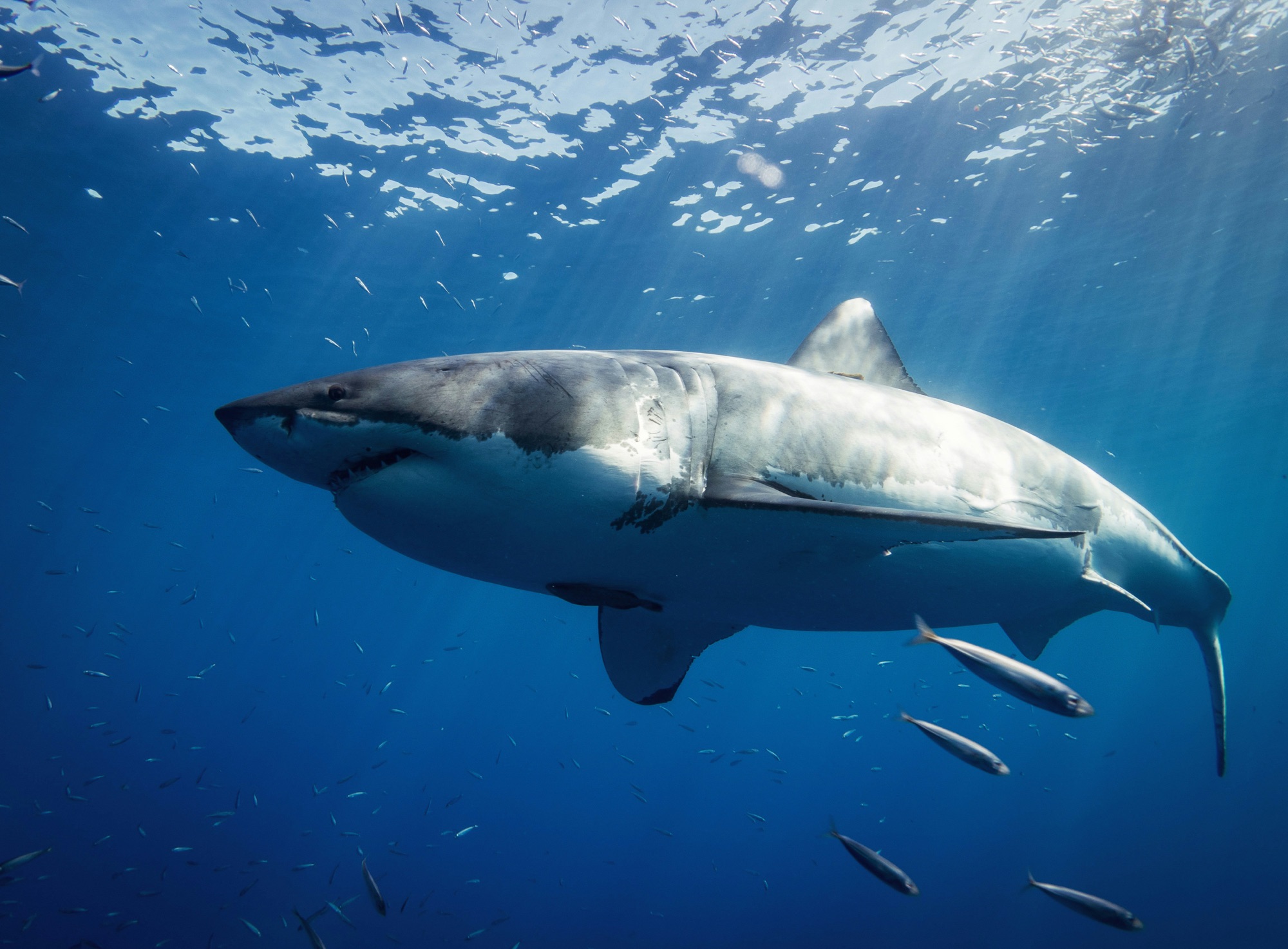The great white shark is one of the most formidable and fascinating predators in the ocean. Its sheer size and power have earned it a fearsome reputation, yet there’s so much more to these creatures than their sharp teeth and predatory skills. Great white sharks are essential players in marine ecosystems, and their biology and behavior are rich with surprising and complex characteristics. Let’s dive into 15 surprising facts about great white sharks, each revealing why these creatures deserve respect and awe.
1. Great Whites Aren’t Actually White
Despite their name, great white sharks are not completely white. Instead, they exhibit a form of coloration known as countershading, which serves as camouflage. The upper portion of a great white’s body is usually a shade of gray, blue, or brown, while their underside is white. This contrast allows them to blend into their environment more effectively.
When viewed from above, the shark’s darker top blends with the deep, dark ocean, making it harder for prey to spot them. Conversely, when viewed from below, their white bellies blend with the brighter water near the surface, helping them remain undetected by predators or prey.
This countershading is critical to their hunting strategy, enabling them to sneak up on their prey. It also helps protect them from larger predators when they are young, as they spend their early years vulnerable to attack from other large marine species like orcas.
2. Great Whites Can Grow Over 20 Feet Long
Great white sharks are among the largest predatory fish on Earth, regularly growing to sizes that dwarf most other marine predators. On average, adult great whites measure between 12 and 16 feet, but some individuals can exceed 20 feet in length and weigh more than 5,000 pounds. The largest great white shark ever recorded was measured at an astonishing 21 feet long.
These massive creatures grow throughout their lives, with females generally being larger than males. Their size allows them to tackle large prey such as seals, sea lions, and even smaller sharks. Their massive size and strength make them apex predators, meaning they have no natural enemies (aside from orcas) once they reach adulthood.
3. Great Whites Can Live for More Than 70 Years
It was once believed that great white sharks lived for only about 30 years, but recent research has overturned this assumption. Studies have shown that great whites can live for more than 70 years, making them one of the longest-living species of fish. This extended lifespan is partly due to their slow rate of reproduction and their place at the top of the food chain, which limits the number of natural threats they face.
Because they mature late in life—males at around 26 years and females around 33 years—their long lifespan is essential for ensuring they reproduce enough to maintain their population. Their ability to live for decades also contributes to their role in maintaining the balance of marine ecosystems, as they help control prey populations over long periods.
4. They Have Over 300 Teeth
One of the most famous features of the great white shark is its formidable set of teeth. A great white typically has 300 serrated, triangular teeth, arranged in rows. These teeth are designed to tear through the flesh of their prey, making them incredibly effective hunters.
What’s even more fascinating is that great white sharks have an almost endless supply of teeth. Throughout their lives, they lose and replace teeth regularly, with new teeth growing in from the rows behind the front ones. This continuous replacement ensures that their teeth are always sharp and ready for their next meal.
Great white shark teeth are not only sharp but also incredibly strong, with a bite force that can reach up to 4,000 pounds per square inch (psi). This powerful bite allows them to easily slice through their prey’s flesh and even break through the bones of larger animals.
5. Great Whites Are Warm-Blooded
Unlike most fish, which are cold-blooded (meaning their body temperature matches the temperature of the surrounding water), great white sharks are partially warm-blooded. They have a unique vascular system called a rete mirabile, which allows them to retain heat generated by their muscles. This system enables them to maintain their body temperature above that of the surrounding water, particularly in key areas such as their muscles, stomach, and brain.
This adaptation gives great white sharks a distinct advantage. It allows them to hunt in colder waters where other sharks cannot survive and helps them stay agile and powerful even in cooler environments. Their warm-bloodedness also helps them swim faster and remain more active for longer periods, making them highly efficient predators.
6. They Can Swim at Speeds of 35 mph
Great white sharks are known for their speed and agility in the water. They are capable of swimming at speeds of up to 35 miles per hour, especially during short bursts when they are chasing prey. This speed, combined with their large size and powerful muscles, makes them one of the ocean’s most formidable hunters.
Their streamlined bodies, strong tails, and muscular build contribute to their ability to swim quickly. When hunting, great whites rely on their speed to surprise their prey, often launching sudden attacks from below. This ability to accelerate rapidly is critical for catching fast-moving prey like seals and sea lions.
In addition to speed, great whites are also known for their impressive endurance. They can swim long distances over extended periods, traveling thousands of miles across oceans during their migrations.
7. Great Whites Are Solitary Hunters
Unlike some marine animals that hunt in groups, great white sharks are generally solitary hunters. They prefer to stalk their prey alone, using their stealth and speed to ambush unsuspecting animals. While they may be seen congregating in areas with abundant food, such as near seal colonies, they usually do not cooperate during hunting.
Great whites are opportunistic feeders, meaning they will eat whatever is available. Their diet consists primarily of seals, sea lions, dolphins, fish, and occasionally other sharks. When hunting, they rely on their keen senses and ambush strategy to catch their prey. They often attack from below, using the element of surprise to their advantage.
Although they are solitary hunters, great whites do occasionally interact with other sharks, especially around feeding sites. These interactions are usually competitive, with larger, more dominant sharks getting the first bite.
8. They Are Not Just Coastal Predators
While great white sharks are often associated with coastal waters, particularly in regions with abundant seal populations, they are also highly migratory and can be found in the open ocean. These sharks are capable of traveling thousands of miles across vast stretches of water in search of food, mates, or warmer waters.
Great whites have been known to undertake long-distance migrations, with some individuals traveling from South Africa to Australia or from the coast of California to Hawaii. These migrations demonstrate their adaptability and ability to survive in a wide range of marine environments, from shallow coastal waters to the deep open ocean.
Their ability to thrive in different habitats is one reason why great white sharks are found in oceans all over the world, from the coasts of North America to South Africa, Japan, and Australia.
9. They Can Jump Out of the Water
One of the most dramatic and awe-inspiring behaviors exhibited by great white sharks is their ability to breach, or leap completely out of the water. This behavior is often observed during hunting, particularly when great whites are targeting seals. The shark attacks from below with such force that it propels itself out of the water, sometimes reaching heights of more than 10 feet.
Breaching is most commonly seen in places like Seal Island off the coast of South Africa, where great whites hunt seals. This behavior not only showcases the shark’s speed and power but also highlights their ambush hunting strategy. By attacking from below and launching themselves out of the water, they catch their prey by surprise, reducing the chances of the prey escaping.
While breaching is often associated with hunting, it is also believed that great whites may breach for other reasons, such as to dislodge parasites or communicate with other sharks.
10. Their Sense of Smell Is Incredible
Great white sharks have an extraordinary sense of smell, one of the most acute in the animal kingdom. They can detect a single drop of blood in 100 liters of water and can smell prey from distances of up to three miles away. This keen sense of smell helps them locate prey, particularly injured or struggling animals, which are easier to catch.
Great whites have large olfactory bulbs in their brains, which allow them to distinguish between different smells and track scent trails in the water. This ability is especially useful in environments where visibility is low, such as murky waters or deep ocean areas.
Their sense of smell is crucial to their survival, allowing them to locate food in vast ocean expanses where prey may be few and far between.
11. They Have a Sixth Sense
In addition to their five basic senses, great white sharks possess a sixth sense known as electroreception. This ability allows them to detect the weak electrical fields generated by the movements of other animals. Special sensory organs called ampullae of Lorenzini are located around the shark’s snout and enable them to pick up on these electrical signals.
Electroreception is especially useful for hunting, as it allows great whites to detect prey even when it is hidden or buried in the sand. This sense also helps them navigate the ocean, as they can detect the Earth’s magnetic fields, aiding in long-distance migrations.
This unique sense gives great whites a significant advantage when hunting in low-visibility conditions, making them even more effective predators.
12. They Are Apex Predators
As apex predators, great white sharks sit at the very top of the marine food chain. This means they have few, if any, natural predators once they reach adulthood. Their status as apex predators plays a critical role in maintaining the balance of marine ecosystems, as they help control the populations of prey species like seals, sea lions, and fish.
By keeping prey populations in check, great whites help prevent overgrazing of marine resources and maintain the health of marine habitats. Without apex predators like great white sharks, marine ecosystems could become unbalanced, leading to overpopulation of certain species and a decline in biodiversity. For example, unchecked populations of seals and sea lions could deplete fish stocks, which would have ripple effects throughout the ecosystem.
In addition to regulating prey populations, great whites also help maintain the genetic health of their prey species by primarily targeting weak, sick, or injured animals. This natural selection ensures that only the strongest individuals survive and reproduce, promoting the overall health of the prey population.
13. Great Whites Rarely Attack Humans
Despite their fearsome reputation, great white sharks rarely attack humans. In fact, most attacks on humans are believed to be cases of mistaken identity. Great whites often mistake swimmers or surfers for seals, which are their preferred prey. Once they realize their mistake, they usually release the human and retreat.
It’s important to note that shark attacks on humans are extremely rare. Statistically, you are far more likely to be struck by lightning or injured in a car accident than to be bitten by a shark. In most cases, shark attacks are not fatal, as great whites typically take an exploratory bite and then retreat once they determine that the human is not a suitable food source.
Research has shown that sharks do not see humans as prey, and they are not actively hunting humans. Great whites are naturally curious animals, and many of the so-called attacks are believed to be the result of investigative behavior, where the shark is trying to figure out what the unfamiliar object (a person) is.
14. Great White Sharks Have Complex Social Behavior
While great white sharks are generally considered solitary creatures, recent research has revealed that they exhibit complex social behaviors. For example, when multiple great whites are present at a feeding site, such as near a whale carcass, they will establish a dominance hierarchy. Larger and more dominant sharks will feed first, while smaller sharks wait their turn. These social interactions suggest that great whites are capable of recognizing and responding to social cues from other sharks.
In some cases, great whites have been observed engaging in non-aggressive interactions with one another, such as swimming together or even playful behavior. These observations challenge the traditional view of great whites as solitary hunters and suggest that they may have more complex social lives than previously thought.
Some studies have also shown that great whites may form temporary social bonds during mating seasons or around abundant food sources. While they do not form long-term social groups like dolphins or whales, these interactions highlight the sharks’ ability to adapt their behavior to different social and environmental conditions.
15. Great Whites Are Vulnerable to Extinction
Despite their status as apex predators, great white sharks are considered vulnerable to extinction by the International Union for Conservation of Nature (IUCN). Several factors threaten their populations, including overfishing, bycatch (being unintentionally caught in fishing nets), and shark finning. In some areas, great whites are targeted for their fins, which are used in shark fin soup, a delicacy in some cultures. This practice has led to a significant decline in shark populations worldwide.
Another threat to great white sharks is bycatch, where sharks are accidentally caught in fishing nets intended for other species. These sharks often die before they can be released back into the water. Additionally, habitat destruction and pollution are major concerns, as they degrade the marine environments that great whites rely on for food and reproduction.
Climate change is also affecting the oceans in ways that could impact great white sharks. Rising ocean temperatures, changing currents, and shifts in prey distribution could force sharks to migrate to new areas, potentially exposing them to new threats, including unfamiliar predators or reduced food availability.
Great whites are slow to reproduce, with females only giving birth to a small number of pups after a long gestation period. They also take many years to reach sexual maturity (around 26 years for males and 33 years for females), which makes it difficult for their populations to recover quickly from declines. These factors mean that the species is particularly vulnerable to overexploitation and population declines.
Conservation Efforts
Efforts to conserve great white sharks are underway across the globe. In many regions, great whites are now protected by law, and international agreements have been established to ban shark finning and regulate fishing practices that threaten sharks. For example, great white sharks are protected in countries like South Africa, Australia, and the United States, where it is illegal to hunt or kill them.
Marine protected areas (MPAs) have also been established in key habitats to safeguard important feeding, mating, and nursery grounds for great white sharks. These areas help ensure that great whites have safe spaces to hunt and reproduce without the threat of human interference.
Organizations such as OCEARCH are also working to learn more about great white sharks through satellite tagging and research, which helps scientists track their movements, understand their behaviors, and implement better conservation strategies. The more we learn about these magnificent creatures, the better equipped we will be to protect them for future generations.
Conclusion
Great white sharks are much more than the fearsome predators often portrayed in popular media. From their incredible sense of smell and electroreception to their complex social behaviors and vital role as apex predators, these sharks are essential to maintaining the health and balance of marine ecosystems. While they have few natural predators, human activities pose a significant threat to their survival.
Conservation efforts are critical to ensuring that great white sharks continue to thrive in the world’s oceans. Through legal protections, marine reserves, and ongoing research, we can better understand and protect these fascinating creatures, ensuring that they remain a part of our oceans for generations to come.
These 15 surprising facts highlight just how extraordinary great white sharks truly are. By learning more about them and supporting conservation efforts, we can help change their reputation from fearsome creatures to valued and essential members of our planet’s marine ecosystem.




